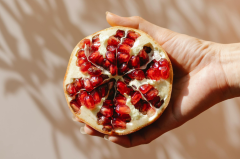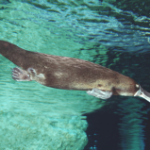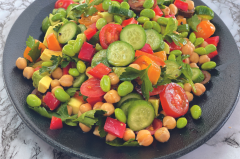Pomegranates have a long, varied, mythological and multicultural history. They are fruit-bearing deciduous shrubs in the Lythraceae family, grow in semiarid climates, are drought tolerant and can tolerate moderate frosts. Pomegranates are thought to have originated in Northern India, Afghanistan and Iran before spreading to Asia, Africa and Europe. They have been cultivated throughout the Middle East, India and Mediterranean for millennia, being domesticated since the fifth millennium BC. There has been long debate by historians whether the pomegranate or the date palm are the original “tree of life”.
Pomegranates were cultivated in Egypt before the time of Moses and possibly the fi rst fruit ever cultivated by humans in Asia Minor. Pomegranate’s name is derived from the medieval Latin pomum or “apple” and granatum “seeded”. Granatum also means “of a dark red colour” – describing the pulp. The modern French term for pomegranate – grenade – has given its name to the military grenade.
Pomegranate’s name is derived from the medieval Latin pomum or “apple” and granatum “seeded”. Granatum also means “of a dark red colour” – describing the pulp. The modern French term for pomegranate – grenade – has given its name to the military grenade.
Throughout the Middle East and Central Asia, the pomegranate was highly revered. In Egypt, being the symbol of prosperity and ambition and in Ancient Greece, it is believed to have sprung from the blood of Adonis and was the food of Persephone in the underworld.
Today the symbolism of the pomegranate is incorporated in all major religions with its ancient and modern meanings encompassing symbols of life, health, prosperity, longevity, femininity, fertility, knowledge, morality and immortality, spirituality, death and resurrection, science and medicine and paradise.
Parts Used
Seeds, peel/rind, juice. Ayurvedic medicine also uses flowers and the root bark. The roots are rich sources of alkaloids. Pomegranate skins are used to dye wool and silk in textile and carpet industries.
Active Ingredients
Pomegranate seeds contain 78 per cent water, 19 per cent carbohydrates, two per cent protein and one per cent fat. A serving of 100g provides 12 per cent of the RDA for vitamin C, 16 per cent vitamin K and 10 per cent folate, with a range of vitamins and minerals including calcium, magnesium, manganese, potassium, copper and zinc. They are a source of dietary fi bre (20 per cent RDA).
The phytochemicals in pomegranate seeds and rind include polyphenols, anthocyanidins and catechins, with a higher phenolic content in the peel. The seed oils contain punicic, palmitic, stearic, oleic and linoleic acids.
Therapeutic Uses
Traditionally, pomegranate was used to treat tapeworms and infections (Ebers Papyrus 1500 BC) and in ancient Ayurvedic medicine was considered “a pharmacy unto itself” being used as an antiparasitic, a blood tonic, and to heal aphthous ulcers, diarrhoea and stomach ulcers.
Gastrointestinal: Pomegranate has shown positive effects in the prevention and trea





